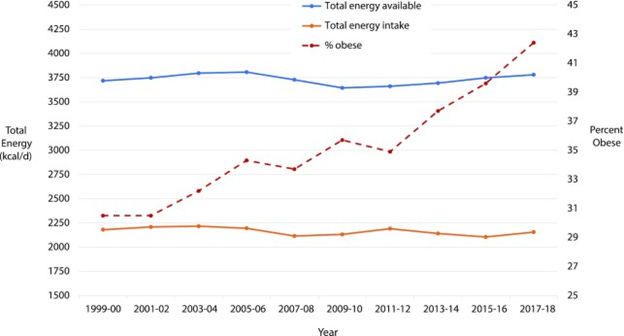Obesity epidemic is not because we are eating more and exercising less
July 28, 2024
Obesity has risen while caloric intake has not
Source: Mozzafarrian, AJ Clin Nutrition, 2022 LINK Energy available (blue line) is human food purchased (based on economic reporting) and energy intake (orange line) is calories actually consumed (based on survey data)
Many think that Americans are getting more obese because they are eating more and exercising less. But there is substantial evidence to the contrary.
I was on a panel in Cleveland with Robert Lustig, a pediatric endocrinologist and emeritus UCSF professor, earlier this month. He’s the author of several books, including Obesity Before Birth Maternal and Prenatal Influences on the Offspring (2010) and Fat Chance: Beating the Odds against Sugar, Processed Food, Obesity, and Disease (2013).
He showed data on caloric intake -- which has been steady over the last two decades, while obesity levels have soared. See the figure above.
He also noted that Americans’ exercise level has increased. This graphic is not from his talk but verifies his point. The portion of Americans who exercise enough to meet guidelines has grown in the last quarter century. Guidelines recommend either 150-300 minutes of moderate exercise or 75-150 minutes of vigorous exercise each week. See figure below:
Source: CDC, 2019 LINK
So, what is the cause of increasing obesity in the US and around the globe?
Clearly, there are some foods that have a higher “glycemic index,” which is why carbohydrates, especially those that are highly processed, cause more insulin release and more weight gain than eating protein or fat. This explains why very low carbohydrate diets (like ketogenic diets) are effective in promoting weight loss.
Lustig focuses attention on ultra-processed foods and obesogens. Foods that have been heavily processed have high glycemic indexes, which stimulate insulin secretion and fat storage. We eat highly processed sugar-coated breakfast cereals instead of whole grain oatmeal, for instance.
Obesogens are a large set of man-made chemicals that cause obesity even without excessive caloric intake. These include plastics and pesticides. They can be found in food packaging and personal care products. This category includes “forever chemicals” that have been in nonstick cookware and stain-resistant fabrics. Many are ‘endocrine disruptors,’ which change human metabolism and can lead to weight gain. Endocrine disruptor exposure before birth and in early childhood is associated with later obesity. Clinical studies have shown that those with higher blood levels of PFAS (perfluorinated alkylate substance, a forever chemical) regain more weight after stopping a diet than those with lower blood levels of this chemical.
Implications for employers:
- Obesity has multiple causes, and childhood weight and even prenatal exposures can predispose people to adult obesity.
- The obesogen hypothesis reminds us that obesity can’t be solved by exhorting people with high BMIs to “just eat less.”
- Employers that offer on-site cafeterias can offer food that is not highly processed and does not contain harmful additives.
- Employers can watch for regulatory action to decrease worker exposure to obesogens.
Thanks for reading. You can find previous posts in the Employer Coverage archive
Please subscribe, “like” and suggest this newsletter to friends and colleagues. Thanks!
Monday: BMI is a flawed measure with few practical alternatives


